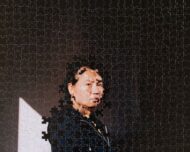A son’s fractured view of the immigrant experience
Tommy Kha’s mother is a recurring subject in his photography, but he didn’t realize until five years into their collaboration that she was an imagemaker herself. In 2016, she gifted Kha a photo album of pictures she made when she first arrived in Canada from Vietnam in the 1980s, before she eventually settled in Memphis, where Kha was born. In his debut monograph, Half, Full, Quarter (Aperture), and accompanying solo exhibition—“Ghost Bites,” at Baxter St at the Camera Club of New York through March 22—Kha’s layered portraits, still lifes, and landscapes exist alongside his mother’s own photographs. The collaborative world between mother and son expands.
My Mom’s immigration experiences and my own upbringing are so different, and the way we treat the camera is so different. My mom’s work came out of celebration and an extension of survival. Her photographs are the kind of thing that most people have in their family’s archives, pictures of birthdays and get-togethers that are markers of their existence. They made it this far and it’s worthy of commemoration and remembrance.
And how much of my identity is my mom? What is really my own making? One of my first “puzzle portraits” is of me and my mom. I took two pictures roughly a year apart and aligned the compositions so that I could swap out some of the puzzle pieces where our bodies met. I was like, “Oh god, I look like my mom.” And I started laughing, but then I realized, “Oh shit, I have my mom’s laugh too.”
I wanted to represent and honor the matriarchy of women who raised me—my grandmother, mom, aunts, and sister. The first piece in “Ghost Bites,” on your immediate right when you enter, was supposed to be of my grandmother. She’s losing her sense of self to dementia, and I wanted to represent her as my new subject and collaborator. Due to the size and configuration of the exhibition space, we had to move the work to the middle, which both derailed and reinforced the thinking behind the show. Now, the exhibition starts and ends with my mom. In a way, it’s my mom’s immigration experience as told by a child of immigrants.
There’s a line of small photos of shrines across the walls that are like vanitas to represent my late aunt. I plan to do a project about her murder, but I also wanted to honor her now. There are two photographs in the book that are very quiet, and they’re the first pictures I made of her last known address according to her autopsy report.
I don’t mention my aunt’s murder explicitly, but it’s connected to what’s happening in this country. I was making those photographs and thinking about Half, Full, Quarter when the Atlanta spa shootings happened, when Michelle Go was pushed in front of an oncoming subway car, and when Christina Yuna Lee was killed in her home. It’s not in the monograph, but there’s a secret photo album in the gallery of pictures I made visiting Christina’s memorial shrine in New York’s Chinatown every Sunday. I wanted those images to be present, but I didn’t want to hang them—it’s not my place, and it didn’t feel right.
It felt so much like how my aunt was killed. While the circumstances are a bit different, it comes from the same place that these anti-AAPI sentiments come from. I can’t believe that these things are still happening. That’s the kind of violence that I don’t particularly want to explicitly represent when I think about haunting. But it’s present.
— As told to Harley Wong
https://www.artforum.com/interviews/a-son-s-fractured-view-of-the-immigrant-experience-90232

